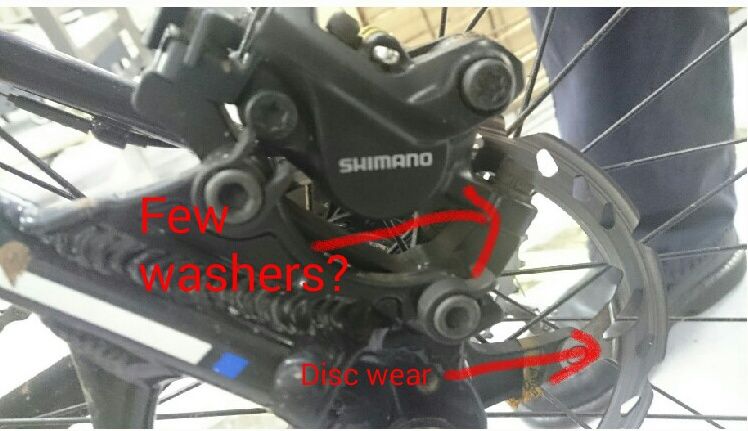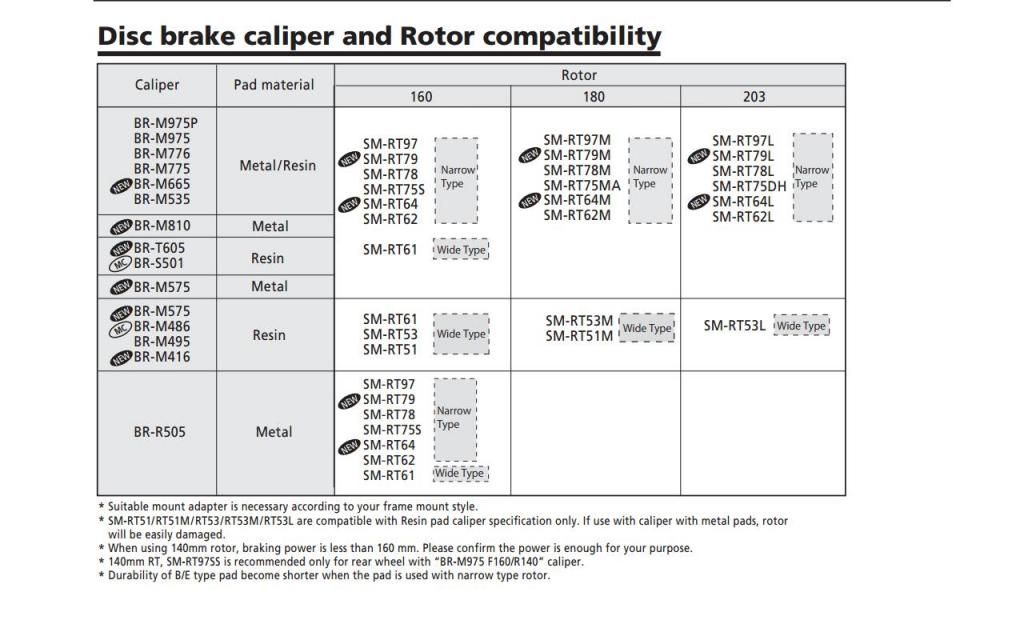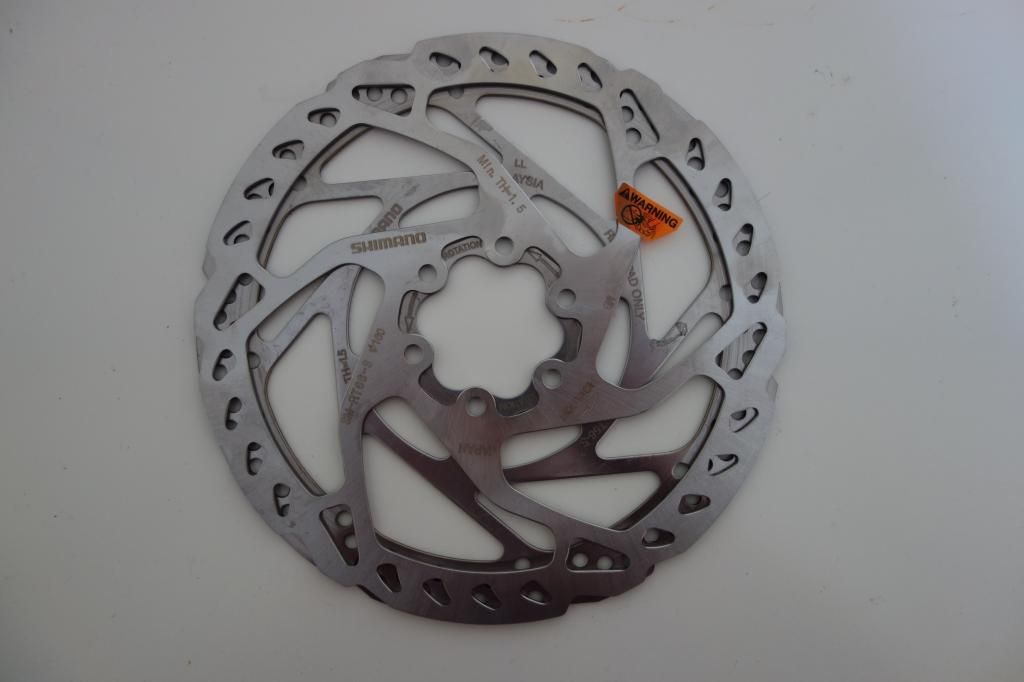![]() You don't need to be an 'investor' to invest in Singletrack: 6 days left: 95% of target - Find out more
You don't need to be an 'investor' to invest in Singletrack: 6 days left: 95% of target - Find out more
As per title...
On the image below you can (hopefully) see the problem. The brake works fine as long as it's flat or slightly downhill. Anything steeper than "gentle slope" and there is no braking on the back at all! I realized this morning, that after upgrading the rotors, which are more slimline than the previously fitted ones the pad has much less contact area with the rotor... Can I raise the caliper about 4, 5 mm using some stainless steel washers, which I've just "borrowed" from the company workshop?
I don't see why the incline makes a difference to the brake? Unless you mean it's not powerful enough?
I don't see why the incline makes a difference to the brake?
More braking power needed to make the bike slow down/stop...
Anything steeper than "gentle slope" and there is no braking on the back at all!
OK - this was the confusing bit.
Nonetheless, clarified.
Is the brake adaptor the right one for your disc size? If you need to space it up about 4-5mm I would say there's something wrong there.
I'm running a 185mm disc with a 183mm adaptor and have a 1mm spacer fitted and works fine.
The adaptor is 160mm, the disc is 160mm too. However the bike came with the RT30 rotors, which have much more "contact area":
[img]  [/img]
[/img]
The RT81 (fitted currently) seem to be a bit "narrower" - I assume that is what causes the issue. On my photo in the first post you can see that the pads wear the disc few mm lower than the pad contact area...
that is one issue yes ,
it is not the issue thats causing your lack of power , poor alignment , sticking piston , contaminated pads or a poor bleed are causing your issue.
I wouldnt space your caliper up as you will end up with the top of the pad not contacting the rotor - and the rest wearing - eventually the tops of the pads will touch and your pad will not be contacting the rotor.
Id just fit disks with the correct track for the pad - you have not upgraded you have simply fitted the wrong disks for your pads.
also more contact area doesnt = more braking force.
Thing about contact point/surface area is that it's counterintuitive- you might think if you have 10% less brake surface you lose power but because the surface area falls and the force on the pads remains the same, the pressure per square inch goes up, which can give enough increased power to compensate for the loss of friction area. Or, not.
Trail Rat is right though, I'd bet 10p this isn't your issue- if your brake was so off-track as to cause so much loss of power, you'd not be able to fix it with washers anyway, a small inaccuracy won't give dramatic differences
The pads are fresh Nukeproof sintered (but the issue was present on different pads before as well). The rotors are nice and clean, also the calipers etc. The whole system works perfectly fine. Except there is not enough power, as I said.
I do believe that extra contact area = more friction = more power...
I will give it a go, raising it up about 2.5mm! 8)
As above.
Also, if the brake worked fine with the old rotor, put it back on.
Problem with the old rotor is that it is "resin pads only" - I used to go through a pair of pads every week in the winter...
If the "trick" doesn't work I will put it back on.
I do believe that extra contact area = more friction = more power
You go girl! It's only science after all.
It looks like a bit of a poxy small rotor. What size is it?
I do believe that disc brakes are actually operated by disc fairies. You've probably killed them off through use of nukeproof pads - you see, by being nuclear proof, they reflect the radiation and everyone knows that's a bad thing. Without the fairies, your braking will be crap.
Old rotor: 160mm
New rotor: 160mm.
Adaptor: 160mm.
All Shimano...
You could raise the caliper a few mm, so that the outer edge of the pad is just below the outer edge of the disc, but you gain an awful ot of power.
I suspect a good bleed will help more.....
ah we have a creationist in our midst.
good luck.
I'm all for the [i]disc faries[/i] idea. Brakes seem to work according to no known laws to man.
I have a particular preparation routine with brakes on several of my bikes, that has involved over the years various combinations of methylated spirits, sand paper, used jam jars, ovens [b]and[/b] random washers, practices which would probably strongly disagree with many a STW'er's personal philosophies.
It seems to work though... 😉
There are far too many tediously dull engineering types on STW at times. Their droning voices often tend to ring far louder also.
Bigger, smaller contact patch - who cares? Just fiddle about with your brakes 'till they work... 😀
bigyinn - MemberYou could raise the caliper a few mm, so that the outer edge of the pad is just below the outer edge of the disc, but you gain an awful ot of power.
I suspect a good bleed will help more.....
Sorry, missed out a "won't", as in "but you WONT gain an awful lot of power".
ah we have a creationist in our midst.
Dinosaurs did not exist! 😈
I measured the distance of the worn out area under the braking surface on the rotor - it was between 2-3mm. Two small washers under each caliper bolt fitted - it felt OK on the short ride around the car park. But there is a steep downhill road when I leave work, with traffic lights at the bottom - that will be the test! 😆
It'll be fine,useful when swapping from 183mm hopes to 185mm avids too
I OTOH am trying to bodge 200mm Avid rotors onto a 203mm Magura setup.
The ebay man lied.
You need a different mount or steady hand with a file....
no_eyed_deer - MemberThere are far too many tediously dull engineering types on STW at times. Their droning voices often tend to ring far louder also.
Well my mum says I'm cool!
Nah but seriously, I think it's interesting, I always assumed more metal = more braking but then I got my ashimas and they turned out to have pretty much identical power to my shimano rotors, despite the entire internet saying they wouldn't.
But there is a steep downhill road when I leave work, with traffic lights at the bottom - that will be the test!
What could possibly go wrong.
What could possibly go wrong.
"PONG!" "PONG!"
I'm not entirely sure if that would be the exact sound the popping caliper bolts would make... 😆
Film the attempt, for posterity.
I have had to do this a few times (using some washers from old brake blocks).
Never to had do more than a couple of mm though as it’s usually to stop the calliper just scraping the top of a disc.
Old pads on new discs usually give poor braking until they “wear-adapt “into the new surface
No problem with spacing them out. You certainly won't die. Look at the alignment washers that Avid use. And they are made of cheese.
I would put(and have in the past without the slightest problem) the spacer washers under each end of the caliper rather than just one, so that the mounting surfaces sit square.
Yeah, there's nothing [i]unsafe[/i] here,it's just not going to fix the problem except possibly by coincidence
Trouble is that if you space the caliper up, the pads will probably overhang the outside of the disc. If they do, the overhanging edges will jam against each other when they rest of the pads are half worn, unless you make a habit of filing the pads level from time to time.
As stated above, the track widths are different. This is quite old, but shows which are which (I think it pre-dates centre lock mountings).
I ran into a similar problem with 6 hole, resin only discs SM-RT56 and SM-RT66 (which are the same diameter, but can take metal pads):
(New over old - the outside diameters are identical)
Happily CRC took the discs back, and there is an obsolete 'wide track' Shimano disc for metal pads - SM-RT 61 which was still available through ebay.
Going by the notes on that table, it's not verboten to use metal pads on a resin only disc, just that "rotor will be easily damaged". The resin-only discs only cost the same as a set of pads, anyway, so that's what I did (sort of):
I stuck some Nukeproof Enduro pads in, and the old 'Resin Only' discs are doing fine 6 months later and are on their second set of Enduro pads. Braking is much, much better (power and feel), and the pads last a decent length of time.
The disc might not be quite as happy with fully metallic pads, but I'd give it a go.
YMMV
I didn't realise anybody took any notice of the resin pads only sign on some Shimano rotors . Nobody I know does and they all seem to survive .
Have the pads and rotor had time to bed in properly? If not, they won't work until they do.
I didn't realise anybody took any notice of the resin pads only sign on some Shimano rotors . Nobody I know does and they all seem to survive.
+1
The [b]pads are fresh[/b] Nukeproof sintered (but the issue was present on different pads before as well). The [b]rotors are nice and clean[/b], also the calipers etc. The whole system works perfectly fine. Except there is not enough power, as I said.
As per DickBarton, I'd be making sure that everything was bedded in properly before ****ing around with the mechanics.
You say the rotors are nice and clean, but they look fairly dirty in the pic.
If you have cleaned them, what with? I try not to touch my discs but when they do get something on them it takes about 4 or 6 isopropanol wipes to clean each one.
And bedding them in seconded, just pulse them on and off down an average hill a couple of times and you will feel them power improve (if they are not contaminated)
Sounds to me like either your brakes need bleeding or the pads and rotors haven't bedded in properly. I find that a light sanding of new pads and new rotors with fine grade paper helps the brakes to bed in faster and also vastly reduces brake squeal. Even tiny amounts of grease from your fingers can diminish braking performance, a good clean and sanding solves this.
I also agree with what others have said about using sintered pads on your rotors, I wouldn't worry about it, some are thicker/thinner/wider etc but essentially they just steel rotors.
Other opinions are available however 😉
OK, I'm alive! 😆
The brake felt a bit better, firmer, with the pads touching more of the disc surface. No bolts popping out 😉
It seemed a bit better breaking, definitely quiter. But on the one dh singletrack they lost all the power after about 15 seconds - I was trying to test it by locking the wheel (the track covered with small rocks): worked only for a short while, then the brake faded totally, as before...
I'm gonna stick the old rotor, but in 180mm size (adapter ordered) and get some softer pads.
Thanks a lot for valuable comments! 🙂
Sounds like they need a good bleed and the pads need bedding in properly.
You won't get full power unless you do a decent downhill run (where you can do a few controlled stops) as the pads need to bed in to the disc surface..
When you say "faded totally" do you mean the lever was still firm but the brakes wouldn't slow the wheel or that the lever was coming back to the bars?
I would think that 15 seconds was quite a short time for the former to occur unless the pads where contaminated.
If the lever is coming back to the bars I'd be looking to bleed the brakes (maybe a complete fluid change).
I use uberbike bike race matrix pads on my shimano resin only discs. Works fine.
those brakes sound like they need a good bleed, or the master cylinder is letting fluid past the seal in sustained application.


